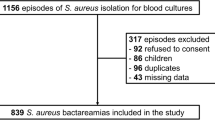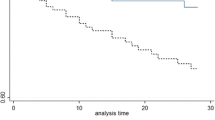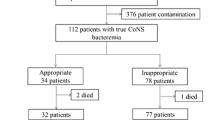Abstract
Staphylococcus aureus is a virulent gram-positive organism, which rarely involves the biliary tract. This study aimed to analyze the clinical characteristics and outcomes of S. aureus bacteremia (SAB) originating from the biliary tract by comparing them with those of catheter-related SAB and biliary Klebsiella pneumoniae bacteremia. A matched case-control study within a prospective observational cohort of patients with SAB was conducted. Biliary SAB was defined as the isolation of S. aureus from blood cultures with symptoms and signs of biliary infection. Biliary SAB patients were matched (1:3) with the control groups: patients with catheter-related SAB and biliary Klebsiella pneumoniae bacteremia. Out of 1818 patients with SAB enrolled in the cohort, 42 (2%) had biliary SAB. Majority of these patients had solid tumors involving the pancreaticobiliary tract or liver, biliary drainage stent, and/or recent broad-spectrum antibiotic exposure. Patients with biliary SAB were more likely to have community-onset SAB, solid tumors, and lower APACHE II score than those with catheter-related SAB. They were less likely to have community-acquired infection and solid tumors and more likely to have lower Charlson comorbidity index and higher APACHE II score as compared with biliary K. pneumoniae bacteremia. The 12-week mortality in the biliary SAB group was higher than those in other control groups (60% vs. 20% and 14%). After adjusting for confounding factors, biliary SAB was independently associated with higher mortality. Biliary SAB is relatively rare. When it is clinically suspected, early aggressive treatment should be considered due to high mortality.
Similar content being viewed by others
References
Rasigade J-P, Vandenesch F (2014) Staphylococcus aureus: a pathogen with still unresolved issues. Infect Genet Evol 21:510–514. https://doi.org/10.1016/j.meegid.2013.08.018
Brook I (1989) Aerobic and anaerobic microbiology of biliary tract disease. J Clin Microbiol 27(10):2373–2375
French AL, Beaudet LM, Benator DA, Levy CS, Kass M, Orenstein JM (1995) Cholecystectomy in patients with AIDS: clinicopathologic correlations in 107 cases. Clin Infect Dis 21(4):852–858. https://doi.org/10.1093/clinids/21.4.852
Sattar I, Aziz A, Rasul S, Mehmood Z, Khan A (2007) Frequency of infection in cholelithiasis. J Coll Physicians Surg Pak 17(1):48–50.
Merchant SS, Falsey AR (2002) Staphylococcus aureus cholecystitis: a report of three cases with review of the literature. Yale J Biol Med 75(5-6):285–291
Nepal SK, Giri S (2012) Panday K (2012) Successful treatment of methicillin-resistant Staphylococcus aureus bacteraemia and cholecystitis. BMJ Case Rep. https://doi.org/10.1136/bcr-2012-007281
Kim J, Gregson DB, Church DL (2011) A case of acute cholecystitis caused by methicillin-resistant Staphylococcus aureus in an immunocompromised patient. Can J Infect Dis Med Microbiol 22(1):e7–e9. https://doi.org/10.1155/2011/202078
Gomi H, Solomkin JS, Schlossberg D, Okamoto K, Takada T, Strasberg SM, Ukai T, Endo I, Iwashita Y, Hibi T, Pitt HA, Matsunaga N, Takamori Y, Umezawa A, Asai K, Suzuki K, Han HS, Hwang TL, Mori Y, Yoon YS, Huang WS, Belli G, Dervenis C, Yokoe M, Kiriyama S, Itoi T, Jagannath P, Garden OJ, Miura F, de Santibanes E, Shikata S, Noguchi Y, Wada K, Honda G, Supe AN, Yoshida M, Mayumi T, Gouma DJ, Deziel DJ, Liau KH, Chen MF, Liu KH, Su CH, Chan ACW, Yoon DS, Choi IS, Jonas E, Chen XP, Fan ST, Ker CG, Gimenez ME, Kitano S, Inomata M, Mukai S, Higuchi R, Hirata K, Inui K, Sumiyama Y, Yamamoto M (2018) Tokyo Guidelines 2018: antimicrobial therapy for acute cholangitis and cholecystitis. J Hepatobiliary Pancreat Sci 25(1):3–16. https://doi.org/10.1002/jhbp.518
Gomi H, Takada T, Hwang TL, Akazawa K, Mori R, Endo I, Miura F, Kiriyama S, Matsunaga N, Itoi T, Yokoe M, Chen MF, Jan YY, Ker CG, Wang HP, Wada K, Yamaue H, Miyazaki M, Yamamoto M (2017) Updated comprehensive epidemiology, microbiology, and outcomes among patients with acute cholangitis. J Hepatobiliary Pancreat Sci 24(6):310–318. https://doi.org/10.1002/jhbp.452
Corredoira J, Alonso MP, Garcia-Garrote F, Garcia-Pais MJ, Coira A, Rabunal R, Gonzalez-Ramirez A, Pita J, Matesanz M, Velasco D, Lopez-Alvarez MJ, Varela J (2014) Streptococcus bovis group and biliary tract infections: an analysis of 51 cases. Clin Microbiol Infect 20(5):405–409. https://doi.org/10.1111/1469-0691.12333
Mermel LA, Allon M, Bouza E, Craven DE, Flynn P, O'Grady NP, Raad II, Rijnders BJA, Sherertz RJ, Warren DK (2009) Clinical practice guidelines for the diagnosis and management of intravascular catheter-related infection: 2009 Update by the Infectious Diseases Society of America. Clin Infect Dis 49(1):1–45. https://doi.org/10.1086/599376
Garner JS, Jarvis WR, Emori TG, Horan TC, Hughes JM (1988) CDC definitions for nosocomial infections, 1988. Am J Infect Control 16(3):128–140. https://doi.org/10.1016/0196-6553(88)90053-3
Friedman ND, Kaye KS, Stout JE, McGarry SA, Trivette SL, Briggs JP, Lamm W, Clark C, MacFarquhar J, Walton AL, Reller LB, Sexton DJ (2002) Health care–associated bloodstream infections in adults: a reason to change the accepted definition of community-acquired infections. Ann Intern Med 137(10):791–797. https://doi.org/10.7326/0003-4819-137-10-200211190-00007
Charlson ME, Pompei P, Ales KL, MacKenzie CR (1987) A new method of classifying prognostic comorbidity in longitudinal studies: development and validation. J Chronic Dis 40(5):373–383. https://doi.org/10.1016/0021-9681(87)90171-8
Chow J, Fine M, Shlaes D, Quinn J, Hooper D, Johnson M, Ramphal R, Wagener M, Miyashiro D, Yu V (1991) Enterobacter bacteremia: clinical features and emergence of antibiotic resistance during therapy. Ann Intern Med 115:585–590. https://doi.org/10.7326/0003-4819-115-8-585
Knaus WA, Draper EA, Wagner DP, Zimmerman JE (1985) APACHE II: a severity of disease classification system. Crit Care Med 13(10):818–829
Singer M, Deutschman CS, Seymour CW, Shankar-Hari M, Annane D, Bauer M, Bellomo R, Bernard GR, Chiche J-D, Coopersmith CM, Hotchkiss RS, Levy MM, Marshall JC, Martin GS, Opal SM, Rubenfeld GD, van der Poll T, Vincent J-L, Angus DC (2016) The Third International Consensus Definitions for Sepsis and Septic Shock (Sepsis-3). JAMA 315(8):801–810. https://doi.org/10.1001/jama.2016.0287
Kochar R, Banerjee S (2013) Infections of the biliary tract. Gastrointest Endosc Clin N Am 23(2):199–218. https://doi.org/10.1016/j.giec.2012.12.008
Diener MK, Ulrich A, Weber T, Wente MN, Buchler MW, Friess H (2005) A case of methicillin-resistant Staphylococcus aureus infection following bile duct stenting. World J Gastroenterol 11(9):1396–1398. https://doi.org/10.3748/wjg.v11.i9.1396
Evangelista V, Goncalves CV, Almeida R, Henriques C, Baptista AM, da Graca JP, Araujo JL (2018) Klebsiella pneumoniae invasive syndrome. Eur J Case Rep Intern Med 5(3):000800. https://doi.org/10.12890/2018_000800
Ruan HQ, Liao GL, Peng P, Liu SQ, Wu CL, Qin JF, Liang ZH, Tang GD, Qin MB, Huang JA (2019) Microbial profiles and risk factors of preexisting biliary infection in patients with therapeutic endoscopy. Gastroenterol Res Pract 2019:1527328. https://doi.org/10.1155/2019/1527328
Acknowledgments
We sincerely thank Mi Young Kim, Jang Mi Go, and Kyung-Mi Bang for their support with the data collection.
Funding
This research was supported by the Basic Science Research Program through the National Research Foundation of Korea (NRF) funded by the Ministry of Education (grant number NRF-2017R1D1A1A09000920).
Author information
Authors and Affiliations
Corresponding author
Ethics declarations
Conflict of interest
The authors declare that they have no conflict of interest.
Additional information
Publisher’s note
Springer Nature remains neutral with regard to jurisdictional claims in published maps and institutional affiliations.
Electronic supplementary material
ESM 1
(DOCX 16 kb)
Rights and permissions
About this article
Cite this article
Yang, E., Lee, J., Seo, H. et al. Clinical characteristics and outcomes of Staphylococcus aureus bacteremia from a biliary source. Eur J Clin Microbiol Infect Dis 39, 1951–1957 (2020). https://doi.org/10.1007/s10096-020-03940-6
Received:
Accepted:
Published:
Issue Date:
DOI: https://doi.org/10.1007/s10096-020-03940-6




